The following assumes that increasingly climate change will force communities, particularly rural ones, towards self-sustainability as far as possible …
In 2050 I’ll be 82 … I’m still living in Glendaruel, in a house built in the 1800s. Still looking out on a pristine hill and nary a wind turbine in sight. from the front at least — they’re all behind the house.
Because oil supplies are intermittent and electricity too expensive like all my neighbours in Colintraive and Glendaruel my heating and hot water is provided by a biomass stove. I installed the kit myself, but the fuel has come from the local community forest, harvested by a management company and regulated by Forestry Commission Scotland.
We all drink water that is supplied from private sources and purified by straightforward passive, and reparable filtration systems. Mains water hasn’t have been pumped in for decades. This suits those who have lived in the glen for most of their lives because they know the water off the hills is probably the most delicious anywhere in the Highlands.
Our electricity needs have been cut to the bone, not because the nuclear power stations haven’t come on line, but because new technologies have reduced all light, electronics and refrigeration to minimal levels. We still require connection to the grid, but only because we are net exporters of electricity. With highly robust, locally maintainable hydro, wind and PV our own needs are met locally. This has meant there has been a fundamental shift in the terms of the relationship between utility company and rural customer. As an exporter of power, represented by a community company, there are agreements in place to ensure that the entire community is never left without power for more than six hours whatever the weather conditions. This is a critical agreement. As the climate worsens maintenance of power supply become ever more important to the vulnerable and elderly. Like me.
Intensive agriculture has been badly hit by the increasingly energetic climate, so the food on our tables is mostly grown in the locality in walled gardens qunder storm-resistance poly tunnel equivalents. While it might be monotonous, vegetables, salads and native fruits make up the major part of our diet, with salmon, mutton and beef providing the protein. The land made over to this production is in part hill farmers utilising their in-bye land, and in part owned by the communities themselves. All of it is co-operatively managed to create surplus for storage and sale. We export food from our community into those which surround us, with local glens specialising in particular types and varieties.
Aside from my contribution to our collective horticulture I still work of course — as an inveterate entrepreneur I can’t stop myself, but in 2050 we are earning our living, not only by producing electricity and growing produce, but also by utilising the 20GB connectivity that is now available to all households across the UK regardless of location.
The infrastructure for such levels of connectivity is not important, the effect is. We now earn over 50% of our income as a community online (instead of a paltry 5% in 2013). Not only because we work from home, but because all payments are taken and received on our “portable connected devices” or the iPhone 42s. This has been a key development in providing work for the influx of families wishing to settle in a more robust, sustainable location.
Of course we are still connected by road, rail and ferry to the major urban areas, but because travel is now elective not compulsory for the huge majority, we choose to remain in our rural location for much of the time. This has become much more entertaining because our community now numbers 5 times more that it did in 2013, and we are, despite the challenging climate more viable now than we were then. And of course by reducing travel we reduce our exposure to the climate and maintain our average life expectancy.
By the way I’ve lived to the ripe old age of 82 not because of the Availability of official medical services but because throughout the community there are medical caches with first aid and paramedic supplies available for locally-based, locally-trained medical personnel to access in case of emergency.
We have actively recruited skills and knowledge to shore up our ability to remain viable in the long term. This positive policy not only results in having the know-how to maintain our local infrastructure and conditions for living, but it also ensures we can communicate and negotiate with partners at local and national level more effectively.
For the really bad times we have continued to develop our village halls. We have two of them, both with hydro for electric, biomass for warmth, boreholes for water and all of it insulated to within an inch of its life. There are medical supplies, dried foodstuffs and much else besides. The idea is for everyone to have multiple redundancies for all the essentials, the last of which is the collective one where resources are shared.
In 2050 I’ll be 82,
Thank you.
